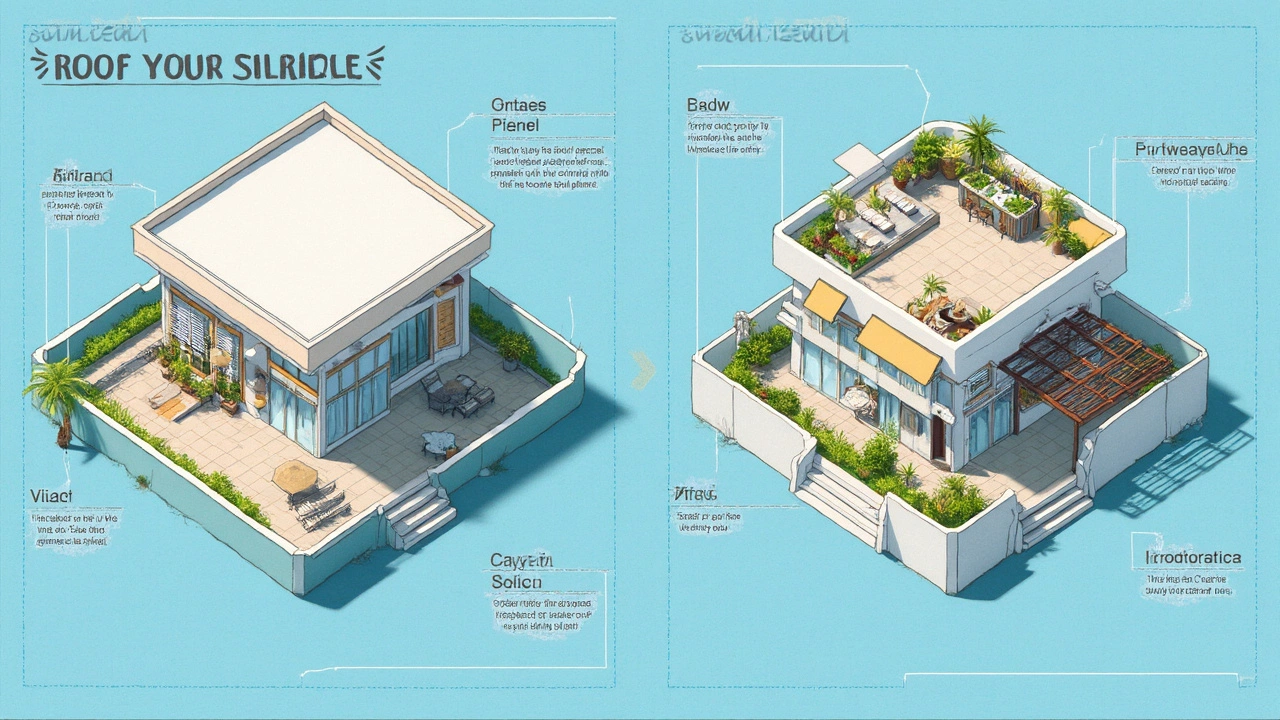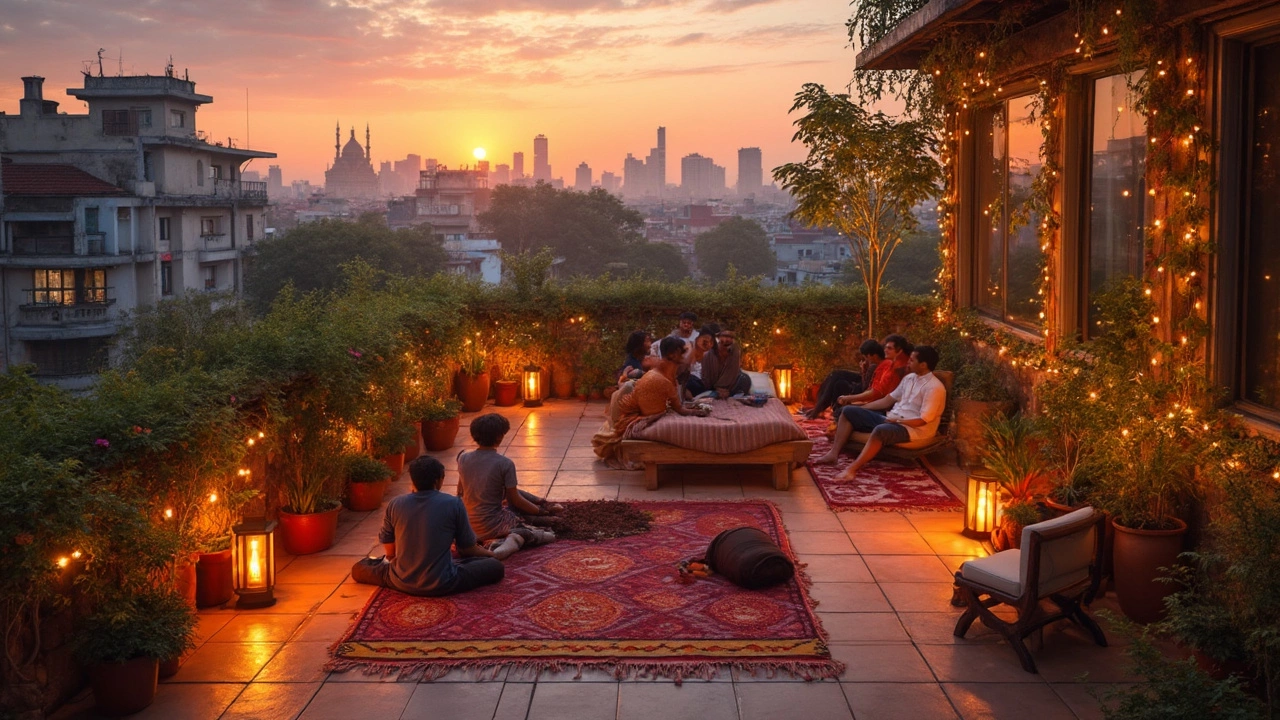If you’re staring at your flat, empty roof and wondering, “Will a roof terrace actually bump up my property’s value?”—you’re not alone. A lot of folks are looking for ways to squeeze more out of existing space, especially in crowded cities or suburbs where every square foot matters.
Here’s the deal. Roof terraces can come with serious perks. They don’t just make your home look cooler. They give you an extra hangout spot, build in privacy, and even offer extra sun for those tomatoes or succulents. The catch? They’re not all cheap or easy to pull off, and if you mess up the details, you might watch your money go down the drain—literally, if you forget about waterproofing.
Buyers today want more than just four walls. They’re thinking about lifestyle, outside vibes, and a bit of wow factor—something a roof terrace totally delivers if you do it right. But before you race up the ladder with a bag of soil, let’s break down what really makes a roof terrace worth it, how buyers see them, and what you need to consider so the upgrade pays you back when it’s time to sell (or just show off to friends).
- Why Roof Terraces Stand Out
- Does a Roof Terrace Boost Your Home’s Value?
- What Buyers Really Want
- How to Plan a Roof Garden (Without Going Overboard)
- Money Talks: Cost vs. Payoff
- Legal and Safety Must-Knows
Why Roof Terraces Stand Out
Let’s face it, everyone wants more usable space. In places where yards are tiny or nonexistent, people crave that little breath of outdoor air. Roof terraces fill that gap—without eating up ground-level square footage. When you turn the roof into a gathering spot or garden, you transform an ignored chunk of property into a serious asset.
The big draw? Roof terrace setups are usually way more private than street-level patios or backyards. You get a clear view, fewer nosy neighbors, and a quieter space. For families with kids (like mine), it's a lifesaver. My kid Rohan loves having a safe place to chase his remote-control cars, and honestly, so do I—no traffic, just sun.
Roof terraces also punch above their weight on daylight. Even on a cloudy day, up top, there’s less shade from nearby buildings. That means more sunlight for plants—perfect for growing herbs, tomatoes, or even a tiny fruit tree. Studies from the University of Reading point out that these spaces can slash stress and boost home happiness too, especially when greened up.
Here’s some data to put things in perspective:
| Feature | Usual Backyard | Roof Terrace |
|---|---|---|
| Sunlight Hours (Average/Day) | 4-5 | 6-8 |
| Noise Level (Average, dB) | 60 | 50 |
| Privacy Score (1-10) | 6 | 9 |
One more thing: adding a roof terrace is like sticking a cherry on top of your house. It shifts the whole look of your place, making it feel surprisingly upscale or modern—no matter how basic it was to start. You’re not just building a deck; you’re upping the vibe of your home and how you use it, every day.
Does a Roof Terrace Boost Your Home’s Value?
Adding a roof terrace isn’t just about making your house look better. There’s pretty solid proof that it can actually give your home value a serious boost—sometimes even more than a new kitchen or a fancy ensuite. Property websites in the UK and US (like Rightmove and Zillow) have shown that homes with a roof terrace or a good-sized balcony often sell for 5% to 12% more than similar places without one. That’s a big jump, especially if your area is short on outdoor space.
The roof terrace acts like an outdoor living room. In busy areas or where backyards are tiny or just don’t exist, buyers pay a premium for private, usable outdoor space. A few years back, a survey of urban property buyers by Hometrack found that after location and square footage, outdoor space was next on the wish list. Roof terraces tick all those boxes at once.
Let’s look at some real numbers to get the idea across:
| City | Average Added Value from Roof Terrace (%) | Extra Sale Price Example ($) |
|---|---|---|
| London | 10-12% | Up to $120,000 |
| New York | 7-11% | Up to $110,000 |
| San Francisco | 8-12% | Up to $145,000 |
| Toronto | 5-9% | Up to $95,000 |
Prices and jumps in value depend a lot on your city, building, and quality of the terrace. If your place is in a neighborhood where green space is rare, expect even more from your investment. But don’t count your chickens yet—you only get these payoffs if your terrace is safe, well-built, and actually feels welcoming (not just a slab of concrete with a couple of chairs).
So, should you expect your home’s value to skyrocket just by sticking plants on the roof? Not exactly. It’s the professionally done terraces—with nice decking, planters, and a spot for food and drinks—that attract buyers with bigger budgets. Quick DIY jobs or flimsy additions barely move the needle.
Value isn’t just about money, either. Many realtors say homes with a usable roof terrace often sell much faster, sometimes cutting listing time in half. In big cities, properties with outdoor living options are snapped up in weeks, not months.
If you dream of family barbecues or a lush little garden above the city noise, there’s a real chance you’ll make your money back if you design your terrace smart—and keep it safe. People are really looking for that mix of home comfort and fresh air. If you can create that, you’re adding value that buyers see immediately.
What Buyers Really Want
If you’re thinking about adding a roof terrace, it pays to know what today’s buyers are actually looking for. It’s not just about extra square footage—buyers want spaces they’ll actually use and brag about. More people are working from home, needing outside space for relaxing, gardening, or having friends over. Agents will tell you: a well-planned roof terrace can turn a ‘maybe’ into a ‘yes’ for a lot of house hunters.
Here’s what buyers pin to the top of their wish list when it comes to roof terraces:
- Privacy: Nobody wants neighbors staring down at their BBQ. Buyers love a spot that feels tucked away but still open to the sky.
- Usable space: It can’t just be a slab of concrete. They want seating, planters, maybe a turf area for kids or pets.
- Views: Even a glimpse of the city or skyline makes a plain roof instantly more interesting.
- Low maintenance: If your terrace looks like it needs hours of weeding or cleaning every week, buyers might run. Simple planters, easy-care furniture, and durable flooring are hot tickets.
- Weatherproofing: Drainage, safe railings, and surfaces that don’t become ice rinks in winter matter more than you think. Most buyers don’t want to fix those problems after moving in.
Got numbers? You bet. Real estate sites in 2024 showed homes with well-finished roof terraces selling for about 5-12% higher compared to similar homes without one in dense city areas. Some buyers even report roof terraces are the feature that made them stretch their budget.
| Feature | Buyer Rating (1-5 stars) |
|---|---|
| Privacy | 4.7 |
| Seating Area | 4.6 |
| Greenery | 4.5 |
| City View | 4.2 |
| Outdoor Lighting | 4.0 |
| Outdoor Cooking/BBQ | 3.8 |
Bottom line: buyers see roof terraces as more than just a bonus—they’re a lifestyle upgrade. Keep future buyers in mind when picking materials, plants, and layouts. Go for long-lasting features, kid-safe details, and chill-out zones anyone would love. That’s how your terrace becomes a real value booster, not just an afterthought.

How to Plan a Roof Garden (Without Going Overboard)
Thinking about turning your roof into a garden? It sounds easy, but trust me, a little planning goes a long way—especially if you want your space to look great and not turn into a mess.
First things first: make sure your roof can actually handle the extra weight. Dirt, water, plants, and furniture all add up. Grab your phone and check in with your building engineer or contractor. Sounds boring, but a quick inspection can save huge headaches (and repairs) later.
- Roof terrace needs solid waterproofing—don’t skip this. One bad rainstorm and you could end up with water dripping into your living room. Modern waterproofing membranes are thinner, easier to install, and a lot more reliable than the old tar-based stuff.
- Lightweight planters are your friends. Stick with plastic, fiberglass, or even recycled materials rather than heavy ceramic or concrete pots. This way you add greenery without stressing your roof beams.
- Pick hardy, drought-tolerant plants unless you want to be up there with a hose every day. Think succulents, lavender, or little evergreens if you’re in a cooler climate. Herbs are a solid pick, too—rosemary, mint, or basil.
- Plan for shade. A cheap umbrella works, but if you want more style go for a retractable awning or build a small pergola. Bonus: it’ll protect your plants from harsh sun.
Keep it simple at first. Starting with just a few raised beds or containers lets you figure out what actually thrives with your wind, sun, and time. You can always add more later. A professor at the Royal Horticultural Society once said,
“The biggest mistake I see? People try to do too much, too fast. Start small, watch what works, then build up.”
Remember, power and water access make life easier. If you’re running extension cords or dragging buckets up stairs, you’ll get tired of roof gardening fast. Check if you can safely add an outdoor tap or solar lights—less hassle, more chill time.
And about those chairs and grills—less is more. Crowd the space and you’ll lose that open-air vibe. Pick stuff that folds or tucks away when not in use. Your future self (and your neighbors) will thank you.
Money Talks: Cost vs. Payoff
So, here’s where people usually get wide-eyed: the numbers. Building a roof terrace doesn’t come cheap. In the U.S. and UK, ballpark costs can run anywhere from $25,000 to $70,000, mostly depending on your location, the size, access (stairs or no stairs), and how fancy you get with materials. If you add things like lighting, couches, or a small outdoor kitchen, expect that number to shoot up fast. Waterproofing is a must, and it’s not somewhere to cut corners—redoing a bad job later gets ugly and expensive.
People often wonder, ‘But does a roof terrace pay off in the end?’ According to a 2024 survey from a major real estate site, homes with well-designed roof terraces can see a value bump of about 8–12% over similar homes without outdoor living space. In big cities—think London, New York, or Chicago—that extra outdoor spot often becomes a big selling point.
Let’s get real, though. The payoff depends on how you do it. Here’s what matters:
- Roof terrace size: A tiny terrace squeezed by mechanical stuff isn’t as valuable as a proper deck where you can fit friends, some plants, or even a grill.
- Access: If buyers have to duck through a closet or need a ladder, your value add drops big time. Safe, easy stairs matter.
- Quality: Cheap wood, wobbly railings, or no drainage? That’ll actually drive your home’s value down. Good craftsmanship wins every time.
- Local taste: In some neighborhoods, a green rooftop gets buyers excited. In others, folks barely use them, so value jumps less.
One thing folks forget: insurance costs might go up a notch, plus property taxes can get a refresh if your city reassesses your swankier place. On the flip side, a great terrace can often speed up a sale and push your home closer to the top end of local price ranges—if buyers can picture themselves grilling, gardening, or chilling up there.
Legal and Safety Must-Knows
You might be excited to lay down the first tile or haul up some planters, but you really can’t skip the boring (but super important) stuff: legal rules and safety checks. Forgetting these can turn your dream project into a money pit—or worse, a legal nightmare. Here’s what you need to know before you even start planning what kind of deck chairs you want.
- Roof terrace projects almost always need approval from your local authority. In the UK, that’s your local council and sometimes the freeholder if it’s a flat. In the US, you have to chat with your city’s building department and probably your Homeowners Association (HOA) too.
- Planning permission isn’t just a formality. It’s about making sure your changes won’t cause issues for neighbors (think privacy, sunlight, or blocking their windows), and that your structure can handle the extra weight (soil, pots, people, furniture).
- In most cities—London, New York, even smaller towns—you’ll need certified plans from a structural engineer to prove the roof can take it. Insurance companies might not cover any damages if you skip this step.
- You’ll need safe access. That means stairs or ladders with railings that follow your city’s building code. Most places insist on railings that are at least one meter (or 42 inches) high with gaps less than 4 inches wide for safety, especially if kids are involved (like my son Rohan, who’d climb anything if he could).
- Drainage and waterproofing aren’t optional. Bad drainage can lead to leaks in your living room (ask anyone who’s had to call an emergency roofer in a rainstorm). Always include proper drainage plans.
Here’s a handy table showing how some basic requirements line up in a few major spots:
| Location | Permission Needed? | Rail Height Min. | Structural Proof? | Waterproofing Required? |
|---|---|---|---|---|
| London | Yes (Planning + Building Regs) | 1m (about 39 in) | Yes | Yes |
| New York City | Yes (DOB permit) | 42 in | Yes | Yes |
| Toronto | Yes | 42 in | Yes | Yes |
One last thing—make sure your insurance covers any new structure. Some folks assume it’s covered automatically, but a quick call to your provider prevents headaches if anything gets damaged. Bottom line: legal hoops and safety aren’t just red tape—they protect you, your investment, and anyone taking in the skyline view with you. Ignore this stuff, and you could be forced to rip your terrace out. Not fun… and not cheap.





